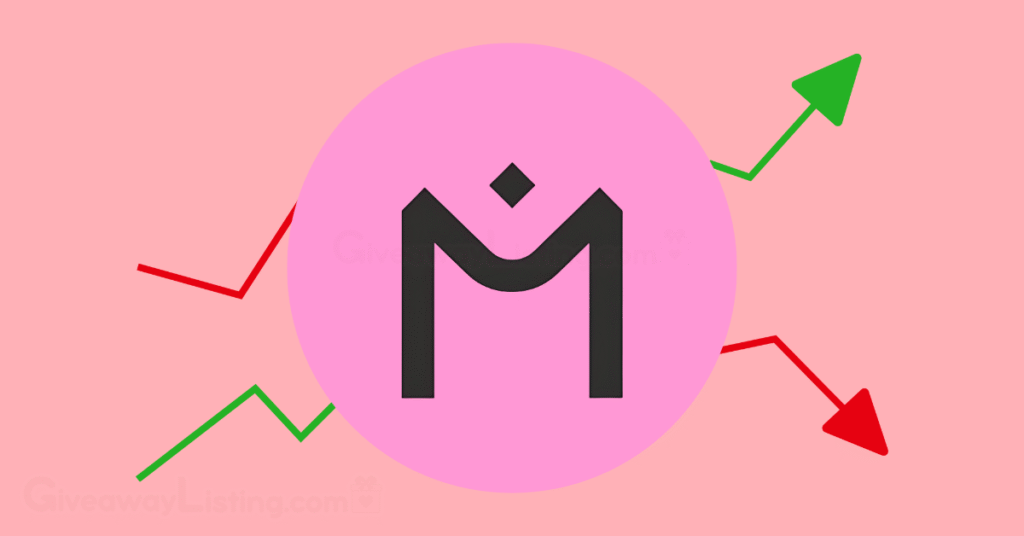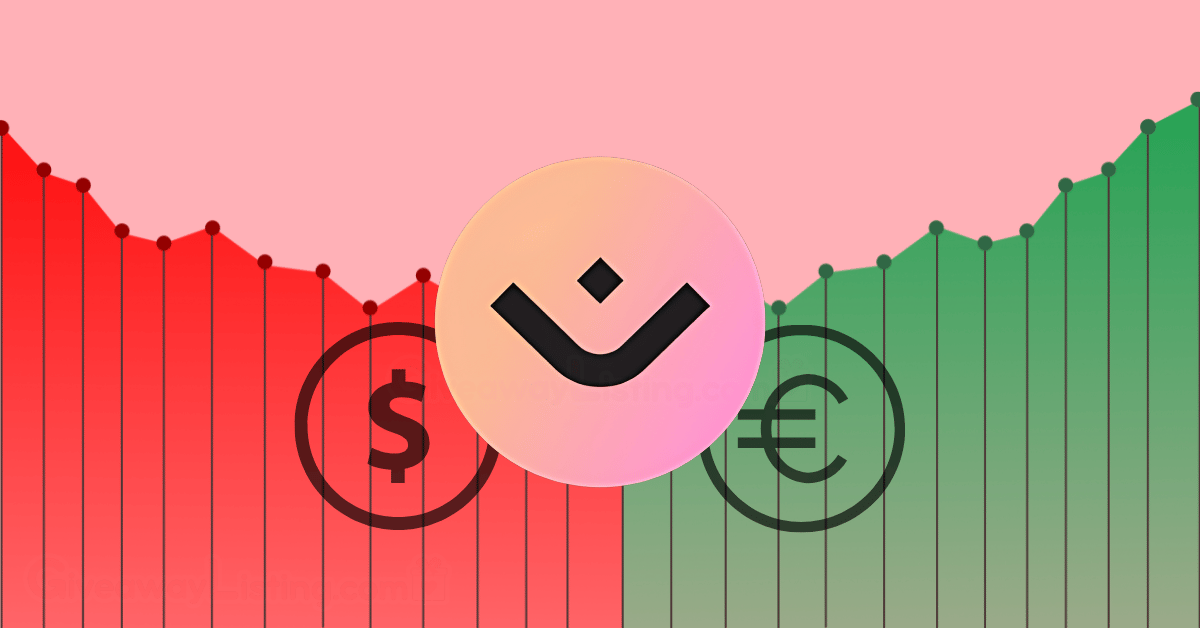OM Price History Until Today
MANTRA is a Layer 1 blockchain built with a clear focus on real-world assets (RWAs). It’s designed to bring physical and traditional financial assets onto the blockchain in a way that meets regulatory standards. Built using the Cosmos SDK, it aims to connect traditional finance with the world of decentralized systems. The network’s native token, $OM, is central to its operation, serving as a key component for network security through staking, transaction fees, and granting holders a voice in governance.
The journey of the $OM token has been a rollercoaster. After its introduction, it experienced a period of relative calm before the wider market downturn in 2022 pushed its value to very low levels. The token found its absolute bottom in October 2023, trading at just over a cent. However, the market’s mood began to change in early 2024, and $OM’s price started a significant climb, reaching an all-time high in February 2025.
A dramatic turn of events followed this peak. On April 13, 2025, the OM token experienced a severe crash, losing over 90% of its value in a matter of hours. This sudden drop was attributed to a cascade of forced liquidations on centralized exchanges. Despite the sharp decline, the project has initiated recovery efforts, including token burns, which have led to some price stabilization and renewed interest from traders.
$OM Price Historical Data From 2020 to 2025
The price of $OM has experienced considerable fluctuations since its market debut, reflecting both its own developmental milestones and the broader cryptocurrency market’s volatile nature.
The data below shows the token’s annual high and low points, illustrating its path from obscurity to a brief multi-billion dollar valuation and its subsequent sharp correction.
| Year | Highest Price (USD) | Lowest Price (USD) |
|---|---|---|
| 2020 | $0.44 | $0.03 |
| 2021 | $0.80 | $0.06 |
| 2022 | $0.08 | $0.02 |
| 2023 | $0.05 | $0.017 |
| 2024 | $0.40 | $0.02 |
| 2025 | $8.99 | $0.49 |
Latest MANTRA Price Prediction for October 2025

Several key elements will shape the price of $OM moving forward. Market dynamics, including the performance and overall health of the cryptocurrency economy, play a significant role. Project-specific developments are also critical, including successful partnerships for RWA tokenization, updates to the MANTRA Chain’s technology, and changes to the token’s economic model, such as token burns.
Forecasting the price for October 2025 reveals a wide range of possibilities, reflecting the uncertainty following the April crash. Some technical analyses indicate a continued recovery, suggesting that if the project’s recovery plans gain traction and market conditions remain favorable, the token could experience positive movement. The team’s commitment to burning a significant portion of the tokens held by the team is a strong factor that could positively influence investor outlook.
On the other hand, some forecasts remain cautious. The memory of the rapid price drop is still fresh, and some investors may be hesitant to re-enter the market. The technical charts show that the token will need to overcome several resistance levels to confirm a new upward trend. The outcome will likely depend on whether the MANTRA team can successfully restore confidence and demonstrate the long-term strength of its RWA-focused platform.
Different analytical models offer varied outlooks for October 2025. Some data-driven forecasts suggest a potential trading range that reflects this division between an optimistic recovery and cautious observation. Below is a summary of the projections from various analytical platforms.
| Platform | Predicted High (USD) | Predicted Low (USD) | Average Price (USD) |
|---|---|---|---|
| Crypto Analysts A | $0.7207 | $0.6111 | $0.6659 |
| Platform B | $0.2177 | $0.2055 | $0.2116 |
| Data Model C | $0.1913 | $0.1885 | $0.1899 |
Best 5 OM Price Predictions in 2025

Predicting the price of MANTRA’s $OM token for 2025 presents a complex picture shaped by extreme volatility and massive potential. Following its catastrophic price drop in April 2025, when it lost over 90% of its value in a matter of hours, market sentiment has been understandably divided.
The event highlighted the token’s vulnerability to market dynamics and liquidity issues on centralized exchanges. Predictions now hinge on the effectiveness of the team’s recovery strategies, including token buybacks and burns, as well as the project’s ability to capitalize on the growing excitement surrounding Real-World Asset (RWA) tokenization.
As a result, 2025 predictions range from conservative estimates of a slow grind back towards the $1 mark to highly optimistic scenarios that see it reclaiming its former glory and pushing for new all-time highs. The outcome will likely depend on broader market conditions and the team’s execution of its ambitious roadmap.
Here are five notable $OM price predictions for 2025 from market analysts and platforms:
1. CoinPedia
Their analysis suggests that as the RWA market matures and gains wider adoption, MANTRA is well-positioned to capture a significant share. This fundamental strength is expected to drive a strong price recovery and upward trend throughout the year.
The platform projects a potential high of $2.01 for $OM in 2025. However, it also acknowledges the possibility of market pullbacks, setting a potential low at $0.50. This results in an average expected price of around $1.25, suggesting that the token will successfully surpass its previous lows and establish a new, higher trading range.
2. Changelly
Analysts at Changelly provide a more moderate forecast based on technical analysis of historical price movements. Their prediction suggests a steady but less explosive growth trajectory for $OM in 2025. This outlook factors in a period of consolidation as the token builds a stronger foundation after its sharp decline, focusing on sustainable growth rather than a rapid, speculative surge.
For 2025, Changelly forecasts a minimum price of $0.68 and a maximum price of $0.76. The average trading price is expected to hover around $0.72. This prediction points to a potential stabilization above its post-crash lows but stops short of anticipating a return to its multi-dollar valuations within the year.
3. CryptoPotato
CryptoPotato presents a highly optimistic scenario, suggesting that if $OM’s price action were to repeat its historical patterns from late 2024 and early 2025, a significant parabolic move could be in the cards. This forecast is heavily dependent on the re-emergence of strong bullish momentum, potentially triggered by major positive news or developments within the MANTRA ecosystem.
Under this bullish framework, the analysis suggests that $OM could attempt to reach a target of $8.50 by the second quarter of 2025. This represents a near-full recovery to its previous all-time high. The prediction also comes with a significant caveat: a failure to maintain this momentum could result in the price dropping back to around $3.00.
4. Traders Union
Traders Union offers a data-driven prediction based on a combination of technical indicators and market analysis. Their forecast anticipates the token building momentum over the course of the year, ending on a stronger note than it began.
By the end of 2025, Traders Union predicts that the price of $OM could reach approximately $1.13. Their analysis does not indicate extreme peaks or troughs, instead favoring a model of sustained growth as confidence returns to the market.
5. CoinCodex
CoinCodex provides a forecast based on an algorithm that analyzes historical data and market sentiment. Their prediction reflects the current uncertainty and volatility surrounding the token. The wide range in their forecast indicates that the token is at a critical juncture, with the potential for both significant gains and further consolidation.
The platform’s 2025 prediction for $OM spans a wide range, with a potential low of $0.65 and a high reaching up to $2.15. This forecast suggests that while a recovery is likely, the path will be volatile. The outcome will heavily depend on whether bullish or bearish sentiment prevails in the market.
Is MANTRA a Good Investment?

Deciding whether MANTRA ($OM) is a good investment requires a careful look at its high-risk, high-reward profile. The project’s primary appeal is its focus on the Real-World Asset (RWA) tokenization market, a sector many believe is poised for explosive growth. MANTRA aims to be a leader in this space by building a security-first, regulatory-compliant Layer 1 blockchain.
However, the immense potential is matched by considerable risks. The 90%+ price crash was a stark reminder of $OM’s extreme volatility and potential liquidity issues. Allegations of centralized control and token supply manipulation, though addressed by the team, have created lingering skepticism in parts of the community. Investing in MANTRA is a bet on both the team’s ability to execute its vision and the broader RWA market’s maturation. The project’s success is far from guaranteed, and the journey is likely to be turbulent.
Advantages of Investing in MANTRA ($OM):
- First-Mover in a High-Growth Sector: MANTRA is one of the early, dedicated Layer 1 blockchains for RWAs, a market projected to grow into a multi-trillion-dollar industry.
- Strong Partnerships and Funding: The project has secured partnerships with major entities like Google Cloud and DAMAC Properties, along with raising millions in funding, which lends credibility and resources for development.
- Regulatory-Compliant Approach: Its focus on adhering to real-world regulations makes it an attractive platform for institutional investors who are often hesitant to enter the DeFi space.
- Passive Income Opportunities: Token holders can stake their $OM to help secure the network and earn rewards, providing a way to generate returns while holding the asset.
- Proactive Team: The leadership team has shown a commitment to transparency and recovery by implementing token burns, buybacks, and improving governance decentralization after the price crash.
Risks of Investing in MANTRA ($OM):
- Extreme Volatility: The April 2025 crash demonstrated that the token is susceptible to massive and rapid price declines, wiping out significant value in a short period.
- Centralization and Tokenomics Concerns: The project has faced criticism regarding its token distribution and the degree of control held by the core team, which can be a red flag for some investors.
- Intense Competition: The RWA and DeFi spaces are highly competitive. MANTRA must contend with established players and new entrants all vying for market share.
- Market Sentiment: The project’s reputation was damaged by the crash. Rebuilding trust and overcoming market skepticism will be a significant hurdle.
For an investor with a high-risk tolerance who believes in the long-term vision of tokenizing real-world assets and is comfortable with severe market swings, MANTRA could be a compelling investment with the potential for substantial returns.
For a more conservative investor who prioritizes capital preservation and stability, MANTRA is likely a poor choice. The demonstrated volatility and existing controversies present risks that may be too great. The investment’s success is heavily tied to the team’s ability to navigate a complex market and deliver on its promises, making it a speculative but potentially rewarding venture.
MANTRA Forecast After 2025

On April 13, 2025, the OM token underwent a significant price decline. The price fell from over $6 to below $0.50, a movement attributed by the team to forced liquidations on centralized exchanges. In the aftermath, recovery efforts were announced, including a plan to burn 300 million team-held tokens to restore confidence.
This event starkly contrasts with its all-time low of approximately $0.017 in October 2023 and its all-time high of nearly $9 in February 2025, illustrating the token’s significant volatility.
The table below shows some of the best price predictions for the years after 2025:
| Year | Minimum Price | Average Price | Maximum Price |
|---|---|---|---|
| 2026 | $1.06 | $1.09 | $1.21 |
| 2027 | $1.58 | $1.63 | $1.87 |
| 2028 | $2.33 | $2.41 | $2.73 |
| 2029 | $3.48 | $3.57 | $4.06 |
| 2030 | $5.20 | $5.34 | $6.08 |
Trading Strategies For MANTRA

Trading a token like MANTRA (OM) requires a well-defined approach due to its demonstrated high volatility. The rapid price swings, including both its climb to nearly $9 and its subsequent crash, present opportunities but also carry substantial risks. A trader without a clear plan can easily fall prey to emotional decision-making, leading to significant losses.
Having a structured trading strategy helps in managing risk, identifying entry and exit points, and maintaining objectivity. Whether you are a short-term or long-term trader, a plan tailored to OM’s market behavior is critical. This involves understanding technical indicators, managing capital effectively, and setting clear rules for when to open and close positions.
A good strategy is not just about predicting price movements but also about preserving capital during unfavorable market conditions.
Swing Trading the Momentum
Swing trading is a strategy focused on capturing gains in a stock or crypto over a period of a few days to several weeks. Swing traders primarily use technical analysis to identify trading opportunities. Given OM’s history of strong upward trends followed by sharp corrections, this method can be particularly effective. The goal is to identify the start of a short-term price movement and enter a position, then hold it until the movement shows signs of ending before taking profits.
When applying this to OM, a trader might look for patterns like consolidations after a major price move or bounces from key support levels. For example, after the price stabilized following the crash, a swing trader could have looked for a confirmation of an uptrend before entering a long position, aiming to ride the recovery wave. Tools such as moving averages and trendlines are useful for identifying the direction of the momentum. This approach avoids the noise of daily trading while still capitalizing on significant market swings.
A crucial part of swing trading is setting stop-loss orders to manage downside risk. For a volatile asset like OM, a stop-loss can prevent a small loss from turning into a catastrophic one. Profit targets should also be established based on resistance levels or a certain percentage gain. This disciplined entry and exit plan is fundamental to successful swing trading.
Day Trading on Volatility
Day trading involves buying and selling a security within a single trading day. Given the significant intraday price fluctuations of the OM token, day traders may find numerous opportunities. This strategy requires a deep understanding of short-term chart patterns and technical indicators, such as the Relative Strength Index (RSI) and Bollinger Bands, to make quick decisions. For instance, an RSI moving into overbought territory could signal a potential short-term drop, presenting a selling opportunity.
The key to day trading OM is active market monitoring and rapid execution. Traders often make multiple trades throughout the day, aiming to profit from small price movements. The high trading volume OM experienced during its recovery phase, often exceeding $280 million in 24 hours, indicates sufficient liquidity for day traders to enter and exit positions without significantly impacting the price. This strategy is high-intensity and requires a considerable time commitment.
Because of the fast-paced nature of day trading, risk management is paramount. Traders should define how much of their capital they are willing to risk on a single trade, often a small percentage like 1-2%. Using tight stop-loss orders is non-negotiable to protect against sudden, adverse price movements. While potentially profitable, day trading is also one of the riskiest methods and is best suited for experienced traders who can remain disciplined under pressure.
Adopting a Core and Satellite Approach
The core and satellite strategy is an investment method that combines passive and active management. The “core” of the portfolio consists of long-term, stable holdings, while the “satellites” are smaller, more speculative positions used to seek higher returns. For someone interested in the MANTRA ecosystem, the core position could involve staking OM tokens, earning passive rewards, and contributing to the network’s security. This aligns with the project’s focus on RWA tokenization.
The “satellite” positions would involve actively trading a smaller portion of one’s OM holdings. This could mean using swing trading or day trading techniques to capitalize on short-term volatility. By separating the portfolio this way, an investor can maintain a stable, long-term position while still engaging with the market’s shorter cycles. This balanced method helps manage risk by ensuring that the bulk of the holdings are not exposed to the high risks of active trading.
This blended strategy enables traders to capitalize on both the long-term growth potential of the MANTRA project and its short-term price fluctuations. It requires a clear allocation plan—for example, 80% of OM holdings in the core (staked) and 20% in the satellite (trading) portions. This method provides a structured approach to interacting with a volatile asset like OM, minimizing excessive risk.
How to Learn More About MANTRA?

MANTRA’s ecosystem, with its focus on tokenizing real-world assets (RWA) and a structure built on the Cosmos SDK, can present a steep learning curve for newcomers. Navigating its features, from staking and governance via the OM token to its various compliance modules, requires some foundational knowledge.
To help beginners get started and stay informed, several key resources are available. Each offers a different type of information, from high-level announcements to community-driven support.
- MANTRA’s Official Website & Docs: This should be the first stop for anyone new to the project. The official site lays out the project’s vision, roadmap, and technical details. The documentation section is particularly valuable, offering in-depth guides on everything from setting up a wallet to interacting with the testnet. It provides the official source of information for understanding MANTRA’s core purpose.
- MANTRA Zone: This is the interactive hub of the ecosystem. Here, users can actively participate by bridging tokens, staking OM, and engaging with liquidity pools. For a hands-on learning experience, there’s no better place. It translates the theoretical knowledge from the docs into practical application, allowing users to see how the network functions firsthand.
- Official X (formerly Twitter) Account: For real-time updates, announcements, and news, the official MANTRA X account is essential. This is where the team communicates major developments, partnerships, and upcoming events. Following this channel ensures you receive timely information straight from the source.
- Community Channels: These platforms are the heart of the MANTRA community. The MANTRA Discord server is a crucial resource, particularly its faucet channel, where users can obtain testnet tokens to experiment on the network without risk. Both Discord and Telegram provide a platform to ask questions, receive support from fellow users and team members, and engage in discussions about the project’s future.
- Block Explorers: For those who want to see the on-chain action for themselves, the official MANTRA Chain Explorer is an invaluable tool. It provides a transparent view of all transactions, wallet addresses, and validator activities on the network. This allows users to verify information and understand the real-time health and activity of the blockchain.
- MANTRA’s Medium Blog: The project’s Medium page features long-form articles and in-depth explorations of specific topics, including tokenomics updates, sybil detection methodologies, and detailed partnership announcements. These posts provide context and clarity that can’t be conveyed in short-form social media updates.
This guide provides a detailed look at MANTRA’s mission to bridge traditional finance with decentralized technology through the tokenization of real-world assets. By examining its core components, the utility of the OM token, and the events surrounding its market volatility, users can get a clearer picture of its position in the market.
The project’s emphasis on regulatory compliance, combined with its robust technical framework, aims to attract institutional and developer interest. For the most current events and breaking stories, you can check out the latest MANTRA news.
The information provided in the content is up to date as of October 2025.
Mantra Price Prediction FAQs
Here are answers to ome frequently asked questions about MANTRA in 2025:
What Is The Future Of MANTRA Coin?
MANTRA’s future is closely linked to the real-world asset (RWA) tokenization market, a sector projected to be worth $10.9 trillion by 2030. The project is actively building its ecosystem with a $108 million fund to support new developers on its network. This focus on a high-growth sector positions the OM coin for potential long-term relevance in the financial industry.
Is MANTRA Bullish Or Bearish?
The sentiment around MANTRA is mixed due to its recent volatility, but many long-term forecasts remain bullish. Some analyses project a potential high of $1.21 in 2026 and suggest it could reach up to $6.08 by 2030. Near-term bearish pressure exists after its significant price drop, making it a high-risk, high-reward asset for traders.
Will MANTRO Crypto Bounce Back?
A rebound is being driven by decisive actions from the MANTRA team. The project has initiated a significant token burn of 150 million OM from the team’s allocation, with another 150 million burn under consideration to reduce the total supply. Following the initial burn, the token saw a price surge of over 30%, showing the market’s positive reaction to these measures.
Can The Om Coin Recover?
The OM coin’s recovery is a primary objective for the MANTRA team following the price collapse of over 90% from its peak. To support this, the team is burning 300 million of its own tokens and has initiated a buyback program. Its recovery hinges on successfully rebuilding investor trust and demonstrating the utility of its RWA-focused blockchain.

